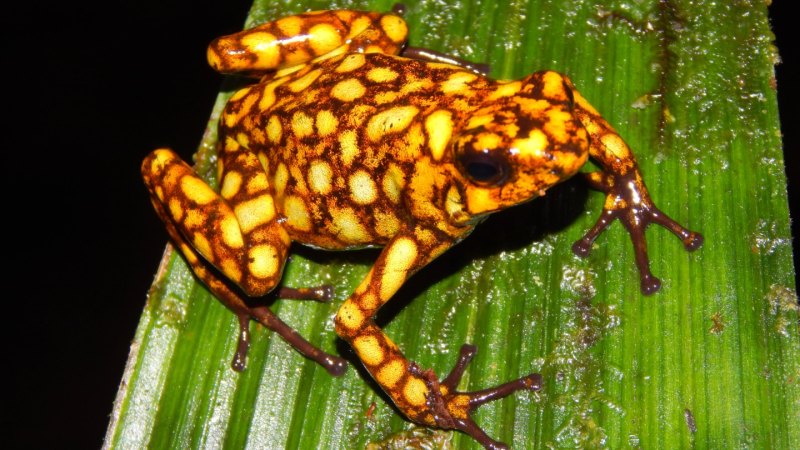Poison? What poison? Some bacteria may treat the powerful toxins bathing poison dart frog skin like a buffet.
The alkaloid chemicals that poison dart frogs wield on their skin increase the variety of microbial species living there, researchers report December 4 in Current Biology. Some of those microbes even seem to dine on the potent alkaloids.
Poison dart frogs (Dendrobatidae) gather and concentrate toxic alkaloids in their bodies from certain poisonous insects and other arthropods in their diet. The chemicals seep out onto the skin and are a potentially lethal deterrent against predators. The alkaloids are also antimicrobial, and biologist Stephanie Caty wondered how they might shape the microbiome on the frogs’ skin.
While she was a graduate student at Stanford University, Caty and her colleagues collected samples of bacteria and fungi from the skin of 11 species of dendrobatid frog from various locations in Ecuador. The researchers analyzed the genes in the samples to identify which microbial species were present. Caty’s team also measured the relative levels of alkaloids in the skin of the frogs, sorting them into high, medium and low alkaloid groups.
Frog species with higher concentrations of toxic alkaloids on the skin had a greater diversity of bacterial and fungal species living on them, the team found. When Caty and her collaborators fed one species of lab-reared poison dart frogs the alkaloid decahydroquinoline, or DHQ, the skin bacteria community became more diverse than it was before.
Together, these findings suggest that the hostile conditions of poison dart frog skin create a unique ecological niche that a subset of microbes exploit.
Some bacteria, specifically, may be thriving because they’re actually feeding on the toxins. The researchers fed ammonium and DHQ to colonies of skin bacteria that were modified with extra heavy versions of nitrogen and carbon. They tracked where those unusual elements ended up, and some bacteria incorporated the DHQ carbon atoms into their own cells.
“It does seem like [the bacteria are] using [the alkaloid carbon] to build up new cell material,” Caty says.
This wouldn’t be the first evidence of bacteria eating toxic alkaloids, she says, but examples from nature are rare. Some bacteria can break down caffeine, for instance. Also, microbes in the guts of desert woodrats digest toxins from creosote plants, sparing their rodent hosts from poisoning.
Poison dart frog alkaloids have almost always been investigated through the lens of their role deterring predators and how they were co-opted from the frogs’ diet, says Andrés Brunetti, a chemical ecologist at the Max Planck Institute for Chemical Ecology in Jena, Germany. But the new findings add “another player to the game.”
“So, now it’s not only the predator and the frog and the mites or the ants that they feed on that interact through alkaloids, but also the microbes,” he says. “This is really wonderful for understanding the complexity of the ecosystem.”
Caty says the findings open so many other avenues for research. For instance, poison dart frogs are generally more resistant to infection or death from the chytrid fungus threatening amphibians globally, she says. The toxins, or the way they tweak the frogs’ sheath of microbial life, may be offering protection somehow.


